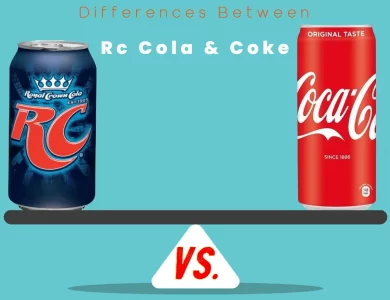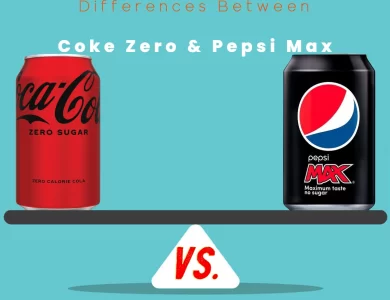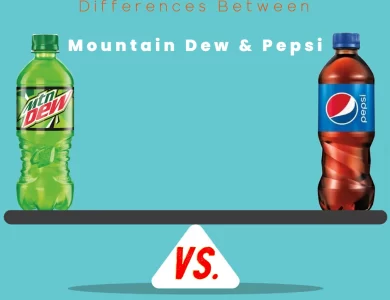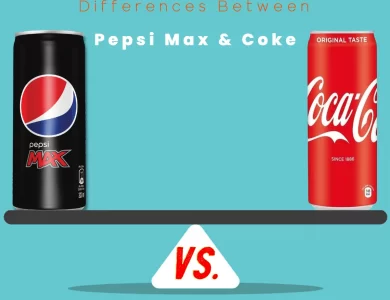
The main difference between Coke Zero and Coke lies in their sweeteners. While Coke is sweetened with high fructose corn syrup (HFCS), Coke Zero is a sugar-free alternative that uses a blend of aspartame and acesulfame potassium for sweetness. This distinction makes Coke Zero an appealing option for those seeking a guilt-free cola experience without the added calories and sugar. On the other hand, Coke, with its classic sweetness derived from HFCS, offers a nostalgic and indulgent taste that has delighted cola enthusiasts for generations.
| Feature | Coke | Coke Zero |
|---|---|---|
| Primary Sweetener | High Fructose Corn Syrup (HFCS) | Aspartame and Acesulfame Potassium |
| Calories | Approximately 140 per 12 fl oz (355ml) | Virtually zero calories |
| Sugar Content | Around 39g per 12 fl oz (355ml) | Zero sugar |
| Taste | Classic cola flavor with HFCS sweetness | Similar taste to Coke, but without the sugar aftertaste |
| Caffeine Content | Approximately 34mg per 12 fl oz (355ml) | Approximately 34mg per 12 fl oz (355ml) |
| Packaging | Classic red label and packaging | Similar red label with a black banner indicating sugar-free |
| Availability | Widely available worldwide | Increasingly available, but not as ubiquitous as Coke |
| Target Audience | General cola enthusiasts | Health-conscious individuals, diabetics, and those on a weight loss journey |
| Environmental Impact | Initiatives to reduce environmental footprint | Aligned with broader sustainability efforts of Coca-Cola |
| Mixology and Culinary Use | Widely used in cocktails and culinary creations | Suitable for guilt-free mixology and culinary experiments |
| Personal Preference | Nostalgia and emotional connection | Sugar-free appeal and healthier choice |
| Shelf Life | Approximately 9-12 months | Approximately 9-12 months |
| Global Recognition | Iconic brand with extensive history | Part of the Coca-Cola family, with growing recognition |
| Branding and Marketing | Established marketing campaigns and slogans | Sugar-free focus and advertising targeted at health-conscious consumers |
| Sweetener Sensitivity | Some individuals prefer HFCS sweetness | No sugar aftertaste for those sensitive to sweeteners |
| Personalization Options | Classic cola experience without customization | Sugar-free option with potential for flavor customization |
| Cultural Impact | Long-standing cultural presence | Gaining popularity and making its mark in pop culture |
If you’ve ever found yourself standing in front of the soda aisle, pondering the eternal question of “Coke Zero or Coke?” fear not, for I am here to guide you through the refreshing world of cola choices. These two titans of the carbonated beverage realm may seem similar at first glance, but oh, my dear readers, they have delightful differences that cater to diverse tastes and dietary needs.
Differences Between Coke Zero and Coke
Ingredients: The Battle of Sweeteners
In the land of cola, sweetness reigns supreme. Coke, the classic, boasts a recipe that includes high fructose corn syrup (HFCS) as its primary sweetener, giving it that familiar sugary kick. On the other hand, Coke Zero takes a different approach by using a blend of artificial sweeteners, primarily aspartame and acesulfame potassium. This clever combination delivers that sweet satisfaction with zero-calorie guilt.
Let’s break it down:
| Coke | Coke Zero | |
|---|---|---|
| Sweetener 1 | High Fructose Corn Syrup (HFCS) | Aspartame |
| Sweetener 2 | Acesulfame Potassium | |
| Calories | Approximately 140 calories per 12 fl oz (355ml) | Virtually calorie-free |
| Sugar | Around 39g of sugar per 12 fl oz (355ml) | Zero sugar |
While both options provide that signature sweetness, Coke Zero emerges as the hero for those seeking a sugar-free or low-calorie alternative.
Caloric Content: Zeroing in on the Difference
In the world of soft drinks, calories can add up faster than bubbles popping. Coke, with its traditional recipe, packs approximately 140 calories per 12 fl oz (355ml) serving. Now, for many, that’s a reasonable splurge once in a while. But for those counting calories or looking to maintain a healthier lifestyle, this can be a concern.
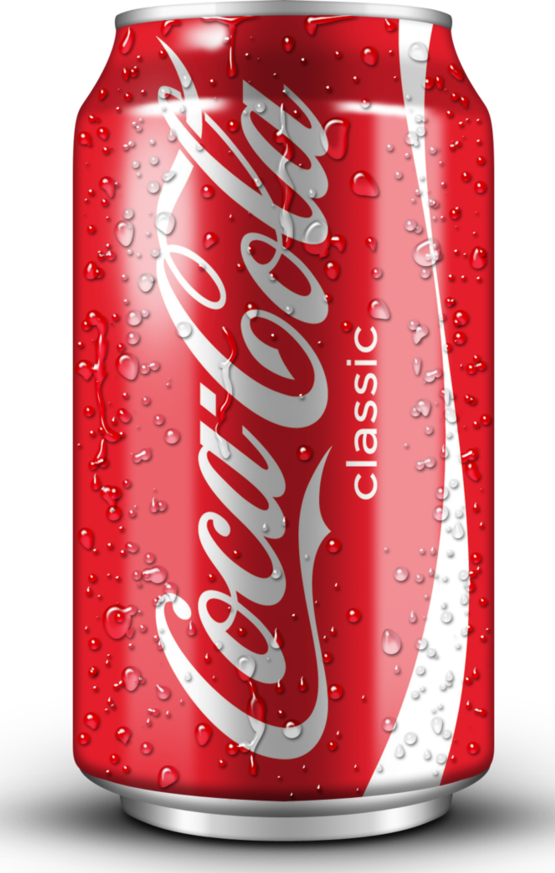
Cue the entrance of Coke Zero, with a confident smile and a grand proclamation of “zero” calories! Yes, you heard it right. Coke Zero contains virtually no calories, making it an appealing choice for the health-conscious folks out there.

Here’s a calorie comparison for a 12 fl oz (355ml) serving:
| Coke | Coke Zero | |
|---|---|---|
| Calories | Approximately 140 | Virtually zero |
If you’re aiming to keep your caloric intake in check while still enjoying the cola experience, Coke Zero is undoubtedly the front-runner.
Taste: The Flavorful Face-off
Now, we come to the heart of the matter – the taste. Coke has been an integral part of our lives for over a century, and its flavor is deeply ingrained in our taste buds and memories. That classic cola taste, with its delightful blend of sweetness and effervescence, is undeniably unique.
Coke Zero, with its sugar-free concoction, does a remarkable job of mimicking the original’s taste. However, it’s important to remember that it’s not an exact replica. Some devoted Coke enthusiasts might notice subtle differences in sweetness or aftertaste due to the alternative sweeteners used.
The key here is personal preference. If you’re a die-hard fan of the original Coke taste and cherish its authentic flavor, sticking to Coke might be your best bet. On the other hand, if you’re open to a slightly different but remarkably similar taste with zero calories and sugar, Coke Zero is waiting to sweep you off your feet.
Caffeine Content: Energizing Insights
Caffeine, that magic ingredient that gives cola its energizing kick. Both Coke and Coke Zero contain caffeine, which can be a game-changer for some people, especially when they need that extra boost of energy to power through the day.
The caffeine content in both drinks is fairly similar:
| Coke | Coke Zero | |
|---|---|---|
| Caffeine | Approximately 34mg | Approximately 34mg |
So, in terms of caffeine, it’s a tie! Whether you choose Coke or Coke Zero, you can count on that caffeine jolt to keep you awake and alert.
Packaging and Availability: Where to Find Them?
When it comes to quenching our thirst for a fizzy fix, availability matters. The classic Coke, being the beloved veteran, can be found in almost every nook and cranny of the world. From grocery stores to restaurants and vending machines, it’s a global superstar.
Coke Zero, on the other hand, might not have the same ubiquitous presence as Coke, but it’s no longer an elusive unicorn. In fact, as the demand for healthier beverage options rises, more and more retailers and establishments are stocking up on Coke Zero to cater to their health-conscious customers.
So, whether you’re in the heart of a bustling city or nestled in a remote countryside, you’re likely to find both Coke and Coke Zero, though Coke might have a more significant edge in terms of sheer availability.
Target Audience: Zeroing in on Preference
One might wonder, is there a target audience for each of these colas? Indeed, there are preferences that might sway individuals towards one or the other.
Coke has an extensive history, and its brand loyalty spans generations. Those who grew up sipping on classic Coke may find comfort and nostalgia in sticking to what they know and love. Additionally, for those who are less concerned about calorie counts and are simply seeking the full-flavored, indulgent cola experience, Coke remains a top choice.
Enter Coke Zero, the suave contender for the health-conscious crowd. For individuals watching their sugar and calorie intake, Coke Zero becomes a true hero. Those who are diabetic, on a weight loss journey, or simply opting for a healthier lifestyle, will likely find Coke Zero to be a fitting alternative.
Packaging and Presentation: The Visual Pop
When it comes to beverages, aesthetics can play a significant role in attracting consumers. Coke has an iconic and timeless packaging design with its classic red label, featuring the bold white Coca-Cola logo. This design has become synonymous with the brand and instantly recognizable worldwide. The traditional glass bottle, as well as cans and plastic bottles, are the common containers for Coke, catering to various preferences.
Coke Zero, true to its name, adopts a similar packaging style to Coke, with the signature red label and white logo. However, to set itself apart, Coke Zero often features a black banner across the top, clearly indicating its sugar-free status. This subtle difference helps consumers easily identify the sugar-free option on the shelf.
In terms of presentation, both Coke and Coke Zero put their best foot forward with eye-catching packaging that appeals to consumers across all ages.
Marketing and Branding: The Battle for Hearts and Minds
When it comes to marketing and branding, Coca-Cola is undeniably a powerhouse. With a history spanning over a century, Coke’s advertising campaigns have left a lasting impact on pop culture. From heartwarming Christmas commercials to catchy slogans, the brand has woven itself into the fabric of society.
Coke Zero, being a relatively newer addition to the Coca-Cola family, has also received its fair share of marketing attention. Positioning itself as a “zero-calorie” alternative to Coke, Coke Zero’s marketing often emphasizes the indulgence without the guilt. It targets health-conscious consumers who seek a lighter beverage option.
While Coke has the advantage of brand recognition and nostalgia, Coke Zero has successfully carved out its own niche, catering to those who want to enjoy the essence of Coke without the added calories.
Worldwide Reception: Cola Diplomacy
As global ambassadors of the cola world, both Coke and Coke Zero have crossed international borders and won the hearts of consumers worldwide. Coca-Cola’s extensive reach and distribution network make it available in more countries than most other brands, making it a popular choice across cultures.
Coke Zero’s international expansion, although not as rapid as Coke, has been steadily growing. As health-consciousness becomes a global trend, Coke Zero’s appeal as a sugar-free alternative has been well-received in various markets.
Each cola, with its distinctive taste and branding, has its own loyal fan base in different parts of the world. Whether it’s sipping on Coke while strolling the streets of New York City or enjoying a chilled Coke Zero on a sunny beach in Sydney, these beverages have become an integral part of various cultures and daily lives.
Environmental Impact: A Sip Towards Sustainability
In an era where environmental concerns are at the forefront, both Coke and Coke Zero have taken steps to address their carbon footprints. Coca-Cola, as a company, has been making efforts to reduce its environmental impact through various initiatives, such as recycling programs, sustainable packaging, and water stewardship.
Coke Zero, being a product under the Coca-Cola umbrella, benefits from these broader environmental endeavors. Additionally, the zero-calorie formula might appeal to environmentally conscious consumers who want to make healthier choices for themselves and the planet.
While the primary environmental impact of both colas is related to their packaging and production, it’s encouraging to see efforts from major beverage manufacturers to move towards sustainability.
Pairings and Mixology: Culinary Combinations
Cola is not just a standalone beverage but also a versatile ingredient in mixology and culinary creations. Whether you’re concocting a classic rum and Coke or using cola to marinate meats for a barbecue, the beverage’s sweet and carbonated nature brings a unique twist to various recipes.
Coke, with its original recipe, has been a staple in mixology for decades, providing a reliable base for a wide range of cocktails and mocktails. Its distinct flavor complements a variety of spirits and ingredients.
Coke Zero, with its sugar-free profile, can be equally versatile in mixology and culinary applications. It allows health-conscious mixologists and home chefs to enjoy the flavors of cola-infused creations without the added calories and sugar.
Whether you’re experimenting in your home bar or exploring culinary delights, both Coke and Coke Zero can be your culinary companions.
Decoding the Cola Codes: Cracking Open the Can
In a world that offers a plethora of beverage choices, understanding product codes is crucial for consumers. Coke and Coke Zero use a standard system of product codes that provide valuable information about each can or bottle.
Product codes are typically printed on the bottom or side of the cans and bottles. They usually include a combination of letters and numbers that indicate various details such as the production plant, production date, and time.
For example, a product code “L1234AB” might break down as follows:
- L: Represents the production plant where the beverage was bottled.
- 1234: Indicates the production date and time, where “12” might represent the 12th day of the month, and “34” could indicate the time of production.
- AB: Additional internal codes or tracking information used by the manufacturer.
Understanding product codes can be helpful for consumers who want to ensure the freshness of their cola or for those who might be collecting memorabilia.
Sweetener Preferences: Exploring Taste Sensitivities
When it comes to artificial sweeteners, individual sensitivities can come into play. Some people might have a preference for the taste of aspartame, while others might find it leaves a slight aftertaste.
Coke, with its use of high fructose corn syrup, appeals to those who enjoy the familiar sweetness of traditional cola. It’s a taste that has delighted cola enthusiasts for generations.
Coke Zero, formulated with aspartame and acesulfame potassium, aims to offer a sugar-free option without sacrificing flavor. Many people find the taste of Coke Zero to be remarkably close to regular Coke, but taste perception can vary from person to person.
For those who are exploring sugar-free options for the first time, it might be worth trying both colas to determine which sweetener profile suits their taste buds best.
Shelf Life and Storage: The Cola Countdown
To preserve the taste and quality of your cola, proper storage is essential. Both Coke and Coke Zero have a relatively long shelf life when stored correctly.
Coke, with its high fructose corn syrup as a sweetener, has a shelf life of about nine months to one year from the production date. It’s best to store Coke in a cool, dry place away from direct sunlight.
Coke Zero, with its artificial sweeteners, has a similar shelf life to regular Coke. As long as it’s stored properly, Coke Zero can maintain its taste and quality for up to one year from the production date.
Remember to check the expiration date on the packaging to ensure you’re enjoying your cola at its best.
Mixing and Blending: The Cola Experimenters
For some cola aficionados, the quest for the perfect cola experience doesn’t end with a plain can or bottle. Mixing and blending colas to create unique flavors has become a popular trend among the curious and adventurous.
With Coke and Coke Zero on hand, the possibilities are endless. From creating your own custom cola blends to experimenting with various syrups and flavors, the world of cola mixology is an exciting playground.
Some enthusiasts might prefer the rich sweetness of Coke mixed with a splash of cherry syrup, while others might enjoy a fusion of Coke Zero with a hint of vanilla extract. The beauty of blending colas lies in discovering flavors that resonate with your taste buds.
So, why not embark on your own cola mixing journey and discover your ultimate concoction? It’s a delightful way to add a personal touch to your cola experience.
Global Recognition: From Coca-Cola to Coke Zero
As we explore the differences between Coke and Coke Zero, it’s important to acknowledge their shared heritage. Both colas belong to the Coca-Cola family, and the brand’s global recognition has played a significant role in their popularity.
Coca-Cola, often referred to as “Coke,” was invented by pharmacist John S. Pemberton in 1886. The iconic name “Coca-Cola” was created by Frank M. Robinson, Pemberton’s bookkeeper, who also penned the famous Coca-Cola logo in Spencerian script.
Fast forward to 1982, when Diet Coke, the first sugar-free option under the Coca-Cola brand, was introduced. It became an instant hit and paved the way for the creation of Coke Zero, which made its debut in 2005.
Today, both Coke and Coke Zero have established themselves as beloved cola choices worldwide, catering to diverse tastes and preferences.
Social Impact: Sharing Happiness, Spreading Joy
Beyond the realm of taste and ingredients, Coca-Cola has had a profound social impact around the globe. The brand’s marketing campaigns, such as “Share a Coke” and “Open Happiness,” have been designed to evoke feelings of joy, togetherness, and positivity.
Through various corporate social responsibility initiatives, Coca-Cola has contributed to community development, education, and environmental sustainability. Their efforts have touched the lives of millions, making a positive difference in countless communities.
Coke Zero, as a part of the Coca-Cola family, shares in the brand’s commitment to social impact. By offering a sugar-free option, it contributes to the health and well-being of individuals looking to make healthier choices.
The power of the cola brand extends far beyond the refreshment it provides, making it more than just a beverage but a symbol of joy and happiness.
Personalization and Customization: Your Cola, Your Way
As consumer preferences continue to evolve, the demand for personalization and customization has become a prominent trend in the food and beverage industry.
Coca-Cola recognized this desire for individuality and launched the “Share a Coke” campaign, which allowed customers to find bottles with their names or the names of their loved ones on the label. This innovative approach tapped into the emotional connection people have with the brand and turned the act of purchasing a Coke into a personal experience.
While Coke Zero might not have received the same level of personalization campaigns, its sugar-free nature attracts a niche of consumers who are customizing their diets and lifestyles.
Personalization options for colas, such as selecting your preferred sweetener or flavor additive, could be an exciting avenue for the future, appealing to consumers’ desire for unique choices.
Cola Culture: Cola in Pop Culture and History
Cola, in all its forms, has a remarkable presence in pop culture and history. From its origins in Atlanta, Georgia, to becoming a global sensation, Coca-Cola’s journey is closely intertwined with the growth of modern consumer culture.
Throughout the decades, Coke has featured in numerous iconic moments in history, entertainment, and sports. The brand’s advertisements have become cultural touchstones, and its logo is displayed proudly in various settings worldwide.
As Coke’s sugar-free counterpart, Coke Zero might not have the same extensive history, but it is a reflection of the evolving consumer demands for healthier options.
Both colas have become symbols of refreshment, joy, and indulgence in their own right, leaving an indelible mark on the world’s beverage culture.

Coke Zero or Coke: Which One is Right for You?
Choose Coke if…
If you’re a fan of the classic cola flavor that has stood the test of time, then Coke is the clear winner. With its iconic red label and rich sweetness from high fructose corn syrup (HFCS), Coke delivers a nostalgic and indulgent experience with every sip. Whether you’re enjoying it at a family gathering, a movie night, or simply craving that familiar taste, Coke is the trusted companion for those who cherish the authentic cola experience. So, if you appreciate the time-honored flavors that have delighted generations, reach for a refreshing can of Coke and let the nostalgia flow.
Choose Coke Zero if…
For health-conscious individuals or those looking to watch their sugar intake, Coke Zero is the perfect choice. With its sugar-free formula made possible by the blend of aspartame and acesulfame potassium, Coke Zero offers the same delightful cola taste without the added calories. If you’re on a weight loss journey, managing diabetes, or simply seeking a guilt-free indulgence, Coke Zero is the hero you need. It’s a guilt-free and refreshing option that lets you enjoy the essence of Coke without worrying about the impact on your waistline or blood sugar levels. Embrace the sugar-free sweetness of Coke Zero and make it your go-to cola for a healthier lifestyle.
In Conclusion
In the epic showdown of Coke Zero versus Coke, the choice ultimately depends on your taste preferences and lifestyle goals. If you crave the classic and indulgent cola experience, then Coke is your perfect match. On the other hand, if you’re looking for a guilt-free, sugar-free option without compromising on taste, then Coke Zero is the clear winner. Whatever you choose, both colas are ready to quench your thirst and deliver a refreshing moment of fizzy delight. So, whether it’s the timeless allure of Coke or the sugar-free appeal of Coke Zero, raise your glass and savor the joy of cola!
FAQs
The primary difference lies in the sweeteners used. Coke is sweetened with high fructose corn syrup (HFCS), while Coke Zero is a sugar-free alternative, using a blend of aspartame and acesulfame potassium for sweetness.
While Coke Zero aims to mimic the taste of regular Coke, it may have a slightly different flavor profile due to the use of artificial sweeteners. Some find Coke Zero remarkably similar to Coke, while others may detect a subtle difference.
Coke Zero is the winner in the calorie department, as it contains virtually zero calories. A 12 fl oz (355ml) serving of regular Coke, on the other hand, contains approximately 140 calories.
Yes, Coke Zero is a sugar-free option and is generally considered suitable for individuals with diabetes. However, it’s always best to consult with a healthcare professional to determine its compatibility with individual dietary needs.
Absolutely! Coke Zero can be a great substitute in mixology and culinary applications. It provides a guilt-free option for those looking to enjoy cola-infused creations without the added sugar.
Coke has been around for much longer and is more ubiquitous, available in almost all corners of the globe. While Coke Zero’s availability is growing, it may not be as widespread as regular Coke.
Both Coke and Coke Zero are products of the Coca-Cola company, which has been actively working to reduce its environmental impact through various sustainability initiatives. Both choices align with a brand that aims to promote environmental responsibility.
Coke Zero is often a preferred choice for those on a weight loss journey due to its zero-calorie nature. However, individual weight loss goals can vary, and it’s essential to consider overall dietary habits and lifestyle choices.
Taste perception can vary from person to person. Some individuals may detect a slight aftertaste from the artificial sweeteners in Coke Zero, while others might not notice any difference.
Cola mixing is a popular trend, and blending Coke and Coke Zero can create a unique flavor experience. Feel free to experiment and find your perfect cola blend!
Read More:
Contents
- Differences Between Coke Zero and Coke
- Ingredients: The Battle of Sweeteners
- Caloric Content: Zeroing in on the Difference
- Taste: The Flavorful Face-off
- Caffeine Content: Energizing Insights
- Packaging and Availability: Where to Find Them?
- Target Audience: Zeroing in on Preference
- Packaging and Presentation: The Visual Pop
- Marketing and Branding: The Battle for Hearts and Minds
- Worldwide Reception: Cola Diplomacy
- Environmental Impact: A Sip Towards Sustainability
- Pairings and Mixology: Culinary Combinations
- Decoding the Cola Codes: Cracking Open the Can
- Sweetener Preferences: Exploring Taste Sensitivities
- Shelf Life and Storage: The Cola Countdown
- Mixing and Blending: The Cola Experimenters
- Global Recognition: From Coca-Cola to Coke Zero
- Social Impact: Sharing Happiness, Spreading Joy
- Personalization and Customization: Your Cola, Your Way
- Cola Culture: Cola in Pop Culture and History
- Coke Zero or Coke: Which One is Right for You?
- In Conclusion
- FAQs
